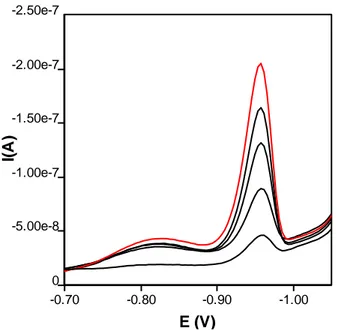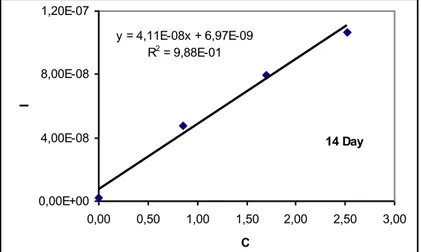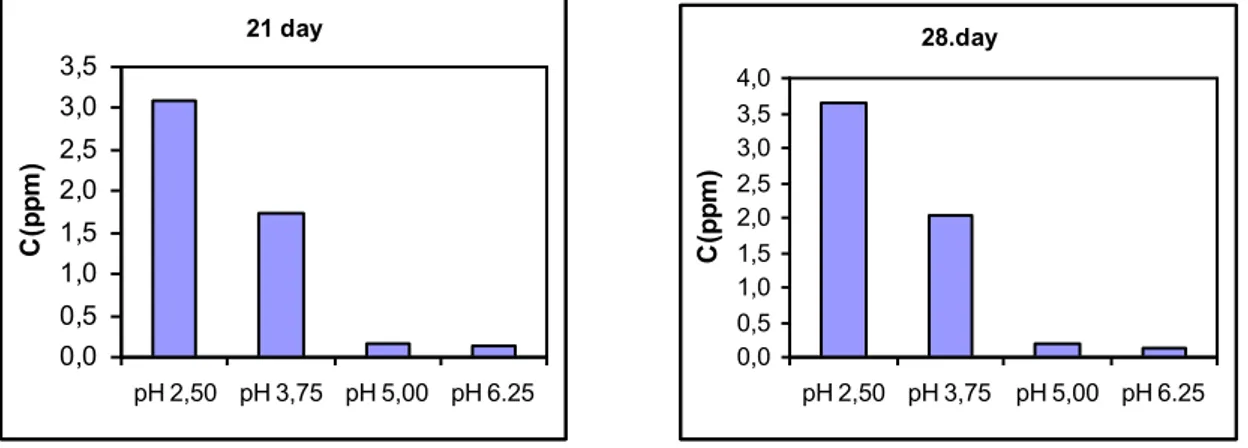Int. J. Electrochem. Sci., 7 (2012) 6465 - 6471
International Journal of
ELECTROCHEMICAL
SCIENCE
www.electrochemsci.org
Investigation of Nickel Ion Release from Stainless Steel Crowns
by Square Wave Voltammetry
Necati Menek1,*, Serpil Başaran1, Yeliz Karaman2, Gözlem Ceylan3, Emine Şen Tunç4
1
Ondokuz Mayıs University, Faculty of Sciences and Arts, Department of Chemistry, 55139 Kurupelit, Samsun-TURKEY
2
Sinop University, Faculty of Sciences and Arts, Department of Chemistry 57000 Sinop-TURKEY
3 Ondokuz Mayıs University, Faculty of Dentistry, Department of Prosthodontics, 55139 Kurupelit,
Samsun-TURKEY
4
Ondokuz Mayıs University, Faculty of Dentistry, Department of Pediatric Dentistry, 55139 Kurupelit, Samsun-TURKEY
*
E-mail: nmenek@omu.edu.tr
Received: 10 January 2012 / Accepted: 6 June 2012 / Published: 1 July 2012
No effort has been made to define nickel magnitude from stainless steel crowns in oral environment. Nickel ions released in sufficient quantities from nickel-containing alloys may induce nickel sensitization or elicit allergic contact dermatitis. In this work nickel ion release from stainless steel crowns in artificial saliva at different days and pH’s has been investigated which is used in pediatric dentistry. Totally 120 stainless steel crowns for primary teeth were immersed to artificial saliva in this study. Nickel in aqueous solutions was determined by square wave voltammetry, using dimethylglyoxime as a complexion agent on mercury electrode. The study revealed that nickel ion release was decreased with increasing pH. Furthermore nickel releasing ratio was decreased in all time periods. Results showed that metal ions released in this experimental condition were well below the critical value to induce allergy and below daily dietary intake level.
Keywords: stainless steel crown, ion release, nickel, square wave voltammetry
1. INTRODUCTION
The preformed metal crowns, more commonly known as the stainless steel crowns (SSCs) were introduced to pediatric dentistry in 1950 [1]. Since that time, SSCs have become an invaluable restorative technique for the treatment of badly broken down primary teeth. The SSCs are extremely durable, relatively inexpensive, subject to minimal technique sensitivity during placement and offers
the advantage of full coronal coverage [2]. Their main disadvantages are periodontal problems, aesthetic concerns and adverse reactions related to ion release [3].
Major constituents of SSCs are nickel and chromium [2]. The potential health effects from exposure to nickel and chromium and their compounds have been scrutinized for more than 100 years, and it was established that this metals could cause allergy [4-11] dermatitis [5,12] and asthma [13].
Most causes for nickel allergies have been attributed to dermatologic exposures to these metals or compounds containing metals [7]. Orthodontic appliances have also been found to produce reactions of hypersensitivity [8]. SSCs which contain 9%-12% nickel are similar to many orthodontic bands and wires [2].
In recent years, modern electroanalytical techniques, especially square wave voltammetry (SWV) which improve sensitivity and selectivity have promoted the development of many electrochemical methods for ultra-traces measurements of a variety of organic and inorganic species. Polarography and voltammetry at mercury electrode is often used for determination of trace nickel. In these methods, nickel is determined on the mercury electrode in the form of Ni (II) complexes and analytical signal is obtained as a results reduction of the complex [14-18].
In this work it has been investigated nickel ion release from SSCs in artificial saliva at different days and pH’s which used in pediatric dentistry.
2. EXPERIMENTAL
Prefabricated same typed and same sized totally 120 SSCs (3M Dental Prouducts, USA) for primary teeth were immersed to artificial saliva (0.4 g NaCl, 1.21 g KCl 1 g urea and 1000 ml distilled water) in this study. Prior to the experiment, crowns were cleaned ultrasonically in a solution of 50 % v/v acetone and 50 % v/v ethanol. For each immersion test condition five stainless steel crowns were used. The SSCs were placed in separate acid-rinsed polyethylene bottles containing 5 ml artificial saliva at pH 2.50, 3.75, 5.00, and 6.25. pH values of all the saliva samples it has been adjusted by concentrated NaOH and HCl. The immersion periods included 1, 3, 7, 14, 21 and 28 days.
All dilutions and sample preparation were made using deionized water. Tartarate buffer (0.1 M) was prepared by mixing the corresponding amounts of tartaric acid and NaOH solution. A dimethylglyoxime (DMG) solution (0.1 M) was prepared by dissolving an appropriate amount in absolute ethanol. Sodium nitrite (5 M) was prepared by dissolving a corresponding amount of the salt in deionized water. DMG and sodioum nitrite were obtained of analytical grade from Merck product. A nickel standard stock solution (0.1 M) was prepared from Merck product and diluted as required.
The voltammetric experiments were carried out using a computer controlled electroanalysis system (Metrohm 757 VA Computrace Electrochemical Analyser). A three electrode combination system was used. This consisted of a Multi Mode Electrode (DME, SMDE and HMDE), an Ag/AgCl reference electrode and a Pt wire auxiliary electrode. All measurements were carried out at room temperature. Voltammetric parameters were selected as equilibrium time 5 s, purge time 300 s, potential step 4 mV, pulse height 50 mV, and scan rate 200 mV/s.
A Jenway 3040 model ion analyser was used to monitor the pH of buffer solutions in the range of 2-12, standardised with pH 7.00 stock buffer and pH 4.00 stock buffer solution.
The solutions were purged with purified clean dry nitrogen for five minutes prior to the experiments in order to remove dissolved oxygen from the media and blanketed thereafter.
Tartarate buffer solution at pH 9.00 value was used as supporting electrolyte at voltammetric studies. 500 μl sodium nitrite and 100 μl sample were added to 10 mL electrolyte at pH 9.50 value. A SWV voltammograms were obtained following the passing of nitrogen for 300 s. It has been used standard addition method for determination of the nickel in artificial saliva.
3. RESULTS AND DISCUSSION
Determination of nickel in the presence of DMG is usually carried out in the presence of tartarete buffer. Sodium tartarate and tartaric acid was used as a main component of the supporting electrolyte. Preliminary experiment shows that the presence of nitrite is necessary for enhancement of the nickel voltammetric peak. Nickel in aqueous solutions can be determined by square wave voltammetry, using DMG as a complexing agent on mercury electrode. In tartarate buffer solution pH 9.00 was used as supporting electrolyte. Catalytic effect of nitrite ions on the current of Ni (II) - DMG complex provides a significant enhancement of the voltammetric response and consequently a considerable decrease of the detection limit of the nickel. In the similar studies nitrite ions are usually used in high concentration ranging from 0.1 to 0.5 M and in the presence of nickel as impurity in this reagent is the reason for the high blank. [19,20]. The SWV voltammograms for the nickel-DMG-nitrite system in tartarate buffer are presented in Figure 1.
-0.70 -0.80 -0.90 -1.00 E (V) 0 -5.00e-8 -1.00e-7 -1.50e-7 -2.00e-7 -2.50e-7 I( A )
Figure 1. SWV voltammograms of the nickel-DMG at tartarate buffer pH 9.00 for 14 th day (a blanck, b sample, c +100 μl Ni, d +200 μl Ni, e+300 μl Ni)
The calibration graph for SWV voltammograms was linear as shown in Figure 2. Calibration equation was calculated as y=4.11.10-8 + 6.97.10-9C (ppm) at pH 6.75. The linear correlation coefficient was r = 0.9761 (Figure 2). At all the experiments results the linear correlation coefficient has been found approximately as r>0.97.
14 Day y = 4,11E-08x + 6,97E-09 R2 = 9,88E-01 0,00E+00 4,00E-08 8,00E-08 1,20E-07 0,00 0,50 1,00 1,50 2,00 2,50 3,00 C I
Figure 2 .Peak current of the nickel dependent on the concentration for 14th day (C= ppm).
1.day 0,0 0,1 0,2 0,3 0,4 0,5 0,6 0,7 pH 2,50 pH 3,75 pH 5,00 pH 6.25 C (p p m ) 3.day 0,0 0,2 0,4 0,6 0,8 1,0 1,2 1,4 1,6 1,8 pH 2,50 pH 3,75 pH 5,00 pH 6.25 C (p p m ) 7 day 0,0 0,5 1,0 1,5 2,0 2,5 pH 2,50 pH 3,75 pH 5,00 pH 6.25 C (p p m ) 14.day 0,0 0,5 1,0 1,5 2,0 2,5 3,0 pH 2,50 pH 3,75 pH 5,00 pH 6.25 C (p p m )
21 day 0,0 0,5 1,0 1,5 2,0 2,5 3,0 3,5 pH 2,50 pH 3,75 pH 5,00 pH 6.25 C (p p m ) 28.day 0,0 0,5 1,0 1,5 2,0 2,5 3,0 3,5 4,0 pH 2,50 pH 3,75 pH 5,00 pH 6.25 C (p p m )
Figure 3. Concentration of the nickel in the solution dependent on the pH at different days
pH = 2.50 0,00 1,00 2,00 3,00 4,00
1.DAY 3.DAY 7.DAY14.DAY21.DAY28.DAY
C (p p m ) pH = 3.75 0,00 1,00 2,00 3,00 4,00 1.DA Y 3.DA Y 7.DA Y 14.D AY 21.D AY 28.D AY C (p p m ) pH = 5.00 0,00 0,05 0,10 0,15 0,20 1.DA Y 3.DA Y 7.DA Y 14.D AY 21.D AY 28.D AY C (p p m ) pH = 6.25 0,00 0,05 0,10 0,15 0,20 1.DA Y 3.DA Y 7.DA Y 14.D AY 21.D AY 28.D AY C (p p m )
Figure 4. Concentration of the nickel in the solution dependent on the days at different pHs
For SSCs, nickel concentrations were investigated dependent on different pH and days. Concentrations of Ni (II) dependent on different pH and days are given in Figure 3 and 4. As shown in figures, the nickel concentrations in the solutions media change with pH. Especially, concentration of Ni (II) decreased with increasing of pH in all time periods. Because, nickel alloys are soluble in acidic media, this situation is usually expected for all the metals in acidic media.
Also, nickel concentration at the different pH values increased with time. In a previous study which aimed to determine nickel ion release was obtained similar results [21].
The study revealed that nickel ion release was decreased with increasing pH. Furthermore nickel ion releasing ratio was decreased in all time periods.
The most common metals or alloys used in dentistry are stainless steel and titanium, as their mechanical and physical properties make them suitable materials. However a major potential disadvantage of these materials is in vivo corrosion [22]. Even though the protective oxide film exists on the metal containing materials, metal ions can still be released from dental alloys in oral cavity through corrosion processes [21]. The release of metal ions from dental materials may have adverse biological effects such as allergy [4-11] dermatitis [5,12] and asthma [13], depending on the ion species and its concentration.
Symptoms of allergic reactions of dental alloys have included severely inflamed hyperplastic gingival tissue surrounding crowns fabricated from a nickel-containing alloy [9], alveolar bone loss from a similar crown [10] and edema of throat, plate and gums [11].
Despite the widespread use of SSCs, there has been only one study in the literature that evaluated the relationship nickel sensitivity and SSCs restorations [23]. In this study Feasby et al. concluded that children with nickel-containing intra oral devices tends to demonstrate a higher positive patch test rate[23].
As reported in the studies, the critical concentration and daily dietary intake level of nickel ion was given as 600-2500 µg [24] and 300-500 µg respectively [25]. In the present study as seen in Figure 3 and 4 released nickel ion concentration level in artificial saliva was found below 4 µg/ml in all pH and time periods. It is well known that the pH of the secreted saliva is approximately 6 in normal conditions. Results showed that metal ions released in this experimental condition were well below the critical value to induce allergy and below daily dietary intake level. Therefore it is concluded that the quantities of metal ions released in the experimental conditions should not be caused for concern in utilizing the SSCs.
4. CONCLUSIONS
In this present study nickel ion release from SSCs in artificial saliva at different days and pH’s has been investigated which is used in pediatric dentistry. Totally 120 stainless steel crowns for primary teeth were studied. Nickel in aqueous solutions was determined by square wave voltammetry, using dimethylglyoxime as a complexion agent on mercury electrode. Results showed that metal ions released in this experimental condition were well below the critical value to induce allergy and below daily dietary intake level.
References
1. W.P. Humphry, Dental Survey, 26 (1950) 945. 2. R.C. Randall, Pediatric Dentistry, 24 (2002) 489.
3. N.S. Seale, Pediatricic Dentistry 24 (2002) 501.
4. L. Peltonen, International J. Dermatology, 20 (1981) 352. 5. J.P. Moffa, J. of American Dental Association 104, (1982) 501.
6. L Blanco-Dalmau, H. Carrasquillo-Alberty and J. Silva-Parra, J. Prosthetic Dentistry, 52 (1984) 116.
7. T. Menne and N.V. Holm, International J. Dermatology, 22 (1983) 22. 8. D.G. Greig, British Dental J., 155 (1983) 61.
9. K.L Kalkwarf, Quintessence International Dental Digest, 15, (1984) 741.
10. I.B. Lamster, D.I. Kalfus, P.J. Steigerwald and A.I. Chasens, J. Periodontology, 58 (1987) 486. 11. W.R. Schriver, R.H. Shereff, J.M. Domnitz, E.F. Swintak and Civjan S, Oral Surgery, Oral
Medicine, Oral Pathology, 42 (1976) 578.
12. F. Brandrup and F.S. Larsen, Contact Dermatitis, 5 (1979) 148.
13. G.T. Block and Yeung M, J. the American Medical Association, 247 (1982) 1600 14. Z. Zhao, X. Cai, J. Pei, Y. Zhang and X. Zhou, Electroanalysis, 3 (1991) 949. 15. N. Menek, S. Topçu and M. Uçar, Analytical Lett, 34 (2001) 1733.
16. S. Topçu, N. Menek , Bull. Electrochem., 19 (2003) 133.
17. S. Patai, The Chemistry of the Hydrazo, Azoxy, and Azo Compounds, John Wiley 1975. 18. N. Menek, and Y. Karaman, Bull. Electrochem., 20 (2004) 399.
19. A. Bobrowski and J. Zarebski, Electroanal., 12 (2000) 1177 20. S.B. Adeloju and A. Hadjıcharri, Anal. Lett., 15, (1999) 95.
21. H.H. Huang, Y.H. Chiu, T.H. Lee, S.C. Wu, H.W. Yang, K.H. Su and C.C. Hsu, Biomater., 24 (2003) 3585.
22. N. Staffolani, F. Damiani, C. Lilli, M. Guerra, N.J. Staffolani, S. Belcastro and P. Locci, J. Dentistry, 27 (1999) 449.
23. W.H. Feasby, E.R. Ecclestone, R.M. Grainger, Pediatric Dentistry, 10 (1988) 127. 24. K. Kaaber, N.K. Veien and J.C. Tjell, British J. Dermatology, 98 (1978) 197. 25. H.A. Schroeder, J.J. Balassa and I.H. Tıpton, J. Chronic Disease, 15 (1962) 941.


